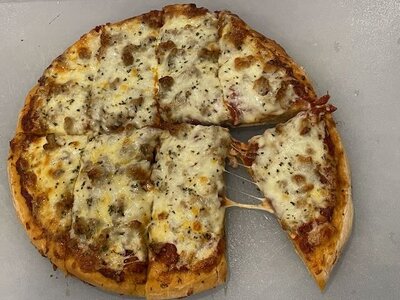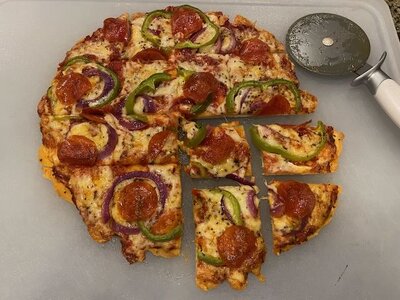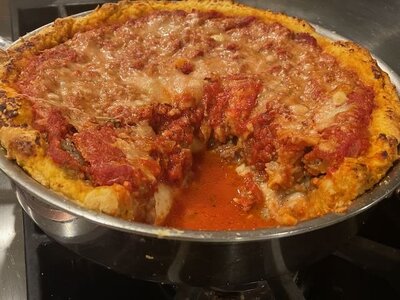All done without leaving home...
We’ve been making a lot of pizza in the cast iron skillet, using prepared dough, commercial sauce, pre-shredded mozzarella, and whatever toppings we feel like at the time.


Skillet pizza is easy, and quite good, but I wanted to branch out into some other styles and use homemade dough and sauce, plus shredded block cheese—all things that should improve quality. Lacking a pizza oven, we were only looking at styles that could be made in the oven, at temps of 450F or lower.
I went to college in the Midwest, and ate a lot of St. Louis Style Pizza. I did get to Chicago on occasion, and had enjoyed Chicago Deep Dish where it was created, at Pizzeria Uno. Googling around I discovered Detroit style, and Quad Cities style, previously unknown to me. Thus began a Midwest pizza tour, making these four very different style pies. There are variations of each, but I used recipes that seemed to represent the consensus style for each type.
Up first was Detroit style, known for a buttery, focaccia-like crust, made with bread flour and baked in a rectangular pan, with cheese directly on the crust, and a slightly-sweet sauce applied in stripes down the length of the pan. Depending on the pizza shop, toppings might be under or over the cheese. We opted for pepperoni, over the cheese and between the sauce stripes. The cheese should be either Wisconsin brick cheese, an aged high-fat buttery cheese cut into cubes, or brick plus mozzarella. Since brick cheese is hard to find outside of the Midwest, I used exclusively mozzarella. The sauce and the cheese are applied all the way to the edge of the pie, where they bake into a crispy edge. Detroit pies are cut in squares, with each square getting part of a sauce stripe.


Next was Quad Cities, named for the five (?!) city metropolitan area along the Mississippi river in Iowa and Illinois. This is a round pie, baked on a round pizza pan. The dough is made with bread flour, and sweetened with a bit of molasses and malt syrup (light corn syrup is a decent substitute), plus a bit of cayenne pepper to balance the sweetness. The dough rises in the refrigerator for 1 to 3 days. Sauce is a traditional recipe, based on crushed tomato and spices, and it is applied fairly lightly to the pie, almost to the edges of the crust. Sweet fennel sausage, finely ground, is a traditional topping, and the raw sausage goes over the sauce, but under the mozzarella cheese. The finished pies have a reasonably thin crust, and are cut into strips with a long pizza scissors, then each strip then cut in half, so the slices are different sizes and have different amounts of crust.


Next was St. Louis style, which is unique in that it uses an unleavened dough, with only a bit of baking powder added to the all-purpose flour, resulting in a thin, cracker-like crust. The sauce is slightly sweet, and spread thinly, almost to the edge of the crust. The cheese is also unique: Provel processed cheese, which seems to be only available in the Midwest. It is a blend of white cheddar, provolone, and Swiss, and shredding and mixing these individual cheeses makes a decent substitute for provel. Popular toppings are pepperoni plus thin rings of green pepper and red onion, so that’s what we used.


Last, we tackled the Chicago Deep dish, the most challenging of the pies to get right. I’ve heard it described as a pizza casserole rather than a pie. We used a 12” skillet with straight walls, and the finished pizza must have weighed 5 lbs…. The crust uses all-purpose flour plus a fair bit of corn meal, with olive oil or butter and a bit of sugar added. This one uses a lot of dough. Traditional toppings are a pound of ground sweet Italian sausage, pre-cooked, plus a layer of pepperoni. Cheese is sliced mozzarella. The sauce is chunky, made from canned plum tomatoes lightly broken up, and simmered with diced onion and spices.. This one also uses a lot of sauce. Assembly is upside down, with the ½” thick mozzarella slices laid down first to fully cover the crust, then the sausage, which forms another ½” thick layer, followed by a layer of pepperoni, then finally a very thick (1/2” +) layer of sauce over the entire pie, right up to the lip of crust that was formed in the pan to hold all of the ingredients together. All you see at this point is tomato sauce, but a heavy dusting of grated parmesan cheese is added right before the pie goes into the oven for a long bake. A 5-10 minute rest is needed after the pizza comes out, to allow it to set enough for slicing and serving. Eating requires a knife and fork—these aren’t slices you can pick up.


All of the pies were good, but our favorites were the Detroit and Quad Cities pies.






